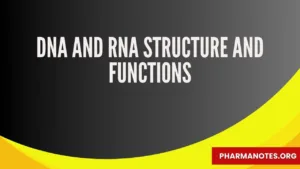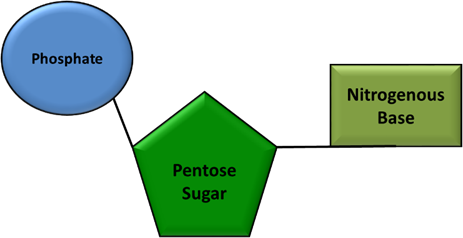DNA and RNA Structure and Functions

DNA and RNA Structure and Functions
Objective
• At the end of this lecture, student will be able to
– Explain DNA double helix
– Discuss the salient features of DNA
– Explain the conformation of DNA double helix
– Explain structure, types and functions of RNA
Discovering the structure of DNA
James Watson and Francis Crick
Worked together at Cavendish Laboratory in Cambridge to determine the structure of DNA
Used work from Franklin, Wilkins, and Chargaff to determine the double helix shape
Watson and Crick were awarded the Nobel Prize
Rosalind Franklin passed away (1958) before the Nobel Prize was awarded in 1962
DNA Structure
DNA is a polymer of deoxy ribonucleotides
It is composed of monomeric units namely
deoxy adenylate (dAMP)
deoxy guanylate (dGMP)
deoxy cytidylate (dCMP)
deoxy thymidylate (dTMP)
DNA consists of two poly deoxyribonucleotide chains twisted around each other on a common axis called a Double Helix
The monomeric deoxy nucleotides in DNA are held together by 3I – 5I phosphodiester bridge
Nucleotides
The phosphate and sugar form the backbone of the DNA molecule, whereas the bases form the “rungs”
Each base will only bond with one other specific base
Adenine (A)
Thymine (T)
Cytosine (C)
Guanine (G)
Structure of polydeoxyribonucleotide
The horizontal line indicate the carbon chain of sugar with base attached to CI
Near middle of horizontal line is C3 phosphate linkage while at the other end of the line is C5 phosphate linkage
A molecule of DNA is made up of millions of tiny subunits called Nucleotides
One Strand of DNA
• The backbone of the molecule is alternating phosphates and deoxyribose sugar
• The teeth are nitrogenous bases
DNA Structure
Watson and Crick proposed the double helical structure of DNA in 1953. it is compared to a twisted ladder
Salient features are
DNA is a right handed double helix
It consist of two poly deoxy ribonucleotide chain, which are twisted around each other on a common axis
Two strands are antiparallel i.e. one strand runs in 5l to 3l direction while other in 3l to 5l direction
Width of a double helix is 20Ao (2nm)
Each turn of the helix is 34Ao (3.4nm) with 10 base pairs of nucleotides
Each pair placed at a distance of 3.4Ao
Each strand of DNA has hydrophilic deoxyribose phosphate back bone on outside of the molecule (periphery)while the hydrophobic base are stacked inside (core)
Two polynucleotide chain are not identical but complementary to each other due to base paring
Two strands are held together by hydrogen bonds formed by complementary base pair
A=T has 2 hydrogen bond
C≡G has 3 hydrogen bond
Hydrogen bond are formed between purine and pyrimidine only
Complementary base pair in DNA helix proves chargaff’s rule i.e. DNA has equal number of adenine and thymine residue and equal number of guanine and cytosine residue
Genetic information residues on one of the two strand known as template strand or sense strand
Because of this complementary base pairing, the order of the bases in one strand determines the order of the bases in the other strand
Double-stranded DNA helix in each chromosome has a length that is thousands times the diameter of the nucleus
For instance, in human, a 2-meter long DNA is packed in a nucleus of about 10 µm diameter
This is made possible by a compact and marvellous packaging and organization of DNA inside in cell
DNA molecules are huge in size
On an average, a pair of B-DNA with a thickness of 0.34 nm has a molecular weight of 660 daltons
Hydrogen Bonds
• The bases attract each other because of hydrogen bonds
• Hydrogen bonds are weak but there are millions and millions of them in a single molecule of DNA
• The bonds between cytosine and guanine are shown here with dotted lines
• When making hydrogen bonds, cytosine always pairs up with guanine
• Adenine always pairs up with thymine
• Adenine is bonded to thymine here
Conformation of DNA double helix
• The double helical structure of DNA exist in at least 6 different forms i.e. A to E and Z
• Among this B, A and Z forms are important. B form of DNA is described by Watson and Crick
| Sl No | Features | B-DNA | A-DNA | Z-DNA |
| 1 | Helical diameter (nm) | 2.37 | 2.55 | 1.84 |
| 2 | Distance per each complete turn (nm) | 3.4 | 3.2 | 4.5 |
| 3 | Each base pair distance (nm) | 0.34 | 0.29 | 0.31 |
| 4 | No of base pair per complete turn | 10 | 11 | 12 |
| 5 | Helix type | Right handed | Right handed | Right handed |
Re and Denaturation of DNA strand
• The two strand of DNA are held by hydrogen bond
• Disruption of bond causes separation of two strand, this phenomenon is called as Denaturation
• Heat, acid and alkali denature DNA
• Renaturation process in which the separated complementary DNA strand can form a double helix
Functions of DNA
DNA serves as the blueprint for life, encoding the genetic instructions necessary for the development, growth, and functioning of organisms. The primary functions of DNA include:
- Genetic Information Storage: DNA stores the hereditary information that determines an organism’s traits and characteristics. This information is encoded in the sequence of nucleotides along the DNA molecule.
- Replication: DNA replication is the process by which a cell duplicates its DNA before cell division, ensuring that each daughter cell receives an identical copy of the genetic material.
- Gene Expression: DNA directs the synthesis of proteins through the process of gene expression. This involves the transcription of DNA into RNA (mRNA) and the translation of mRNA into protein.
• Nucleic acid that contains the genetic instructions for the development and function of living things
• Main role of DNA in the cell is the long-term storage of information
RNA Structure
RNA is a polymer of ribonucleotides held together by 3’,5’-phosphodiester bridges
Sugar in RNA is ribose in contrast to deoxy ribose in DNA
RNA contains the pyrimidine uracil in place of thymine (in DNA)
RNA is usually a single stranded polynucleotide
Chargaff’s rule is not obeyed as there is no specific relation between purine and pyrimidine contents
Types of RNA:
mRNA – about 5-10% of cellular composition, transfers genetic information from genes to ribosomes to synthesize proteins
tRNA – about 10-20% of cellular composition, transfers amino acid to mRNA for protein biosynthesis
rRNA – about 50-80% of cellular composition, provides structural framework for ribosomes
Functions of RNA
RNA plays diverse roles in the cell, serving as a mediator between DNA and protein synthesis. The main functions of RNA include:
- Transcription: RNA polymerase enzymes transcribe DNA into RNA during the process of transcription. The resulting mRNA carries the genetic information from the nucleus to the cytoplasm, where it serves as a template for protein synthesis.
- Translation: mRNA is translated into protein by ribosomes in the cytoplasm. Transfer RNA (tRNA) molecules ferry amino acids to the ribosome, where they are assembled into polypeptide chains according to the sequence of codons on the mRNA.
- Regulation of Gene Expression: Certain types of RNA, such as microRNA (miRNA) and small interfering RNA (siRNA), play roles in regulating gene expression by controlling the stability and translation of mRNA molecules.
It assists DNA and acts as a messenger between DNA and ribosomes
It helps the ribosomes to choose the right amino acid which is required in building up of new proteins in the body
Differences Between DNA and RNA
While DNA and RNA share some structural similarities, they also exhibit key differences:
- Sugar: DNA contains deoxyribose sugar, while RNA contains ribose sugar.
- Bases: DNA uses thymine as one of its nitrogenous bases, whereas RNA uses uracil in its place.
- Strandedness: DNA is typically double-stranded, while RNA is usually single-stranded.
- Function: DNA primarily serves as the genetic blueprint, while RNA is involved in various aspects of gene expression and protein synthesis.
Summary
• DNA is a polymer of deoxyribonucleotides
• Watson and Crick proposed the double helical structure of DNA
• The two strands are held together by hydrogen bonds formed complementary base pairs
• DNA exist in 6 different form A to E and Z
• Separation of two strand of DNA is called Denaturation
• Fusion of two strands is called Renaturation
• RNA is usually a single stranded polynucleotide
FAQs (Frequently Asked Questions)
- What is the role of DNA in inheritance? DNA contains the genetic information passed from parents to offspring, determining traits such as eye color, height, and susceptibility to diseases.
- How does RNA differ from DNA? RNA differs from DNA in several ways, including the type of sugar present (ribose in RNA, deoxyribose in DNA) and the presence of uracil instead of thymine.
- What are the three main types of RNA, and what are their functions? The three main types of RNA are messenger RNA (mRNA), transfer RNA (tRNA), and ribosomal RNA (rRNA). mRNA carries genetic information from DNA to the ribosome, tRNA brings amino acids to the ribosome during protein synthesis, and rRNA forms the structural and catalytic components of ribosomes.
- How does DNA replication ensure the fidelity of genetic information transfer? DNA replication is a highly accurate process that involves proofreading mechanisms to correct errors. DNA polymerase enzymes check for mismatches between nucleotides and repair any mistakes that occur during replication.
- What are some applications of understanding DNA and RNA structure and functions? Understanding DNA and RNA is essential for various fields, including medicine, agriculture, forensic science, and biotechnology. It enables researchers to study genetic diseases, develop new drugs, improve crop yields, and solve crimes through DNA analysis.
Also, Visit:
B. Pharma Notes | B. Pharma Notes | Study material Bachelor of Pharmacy pdf








